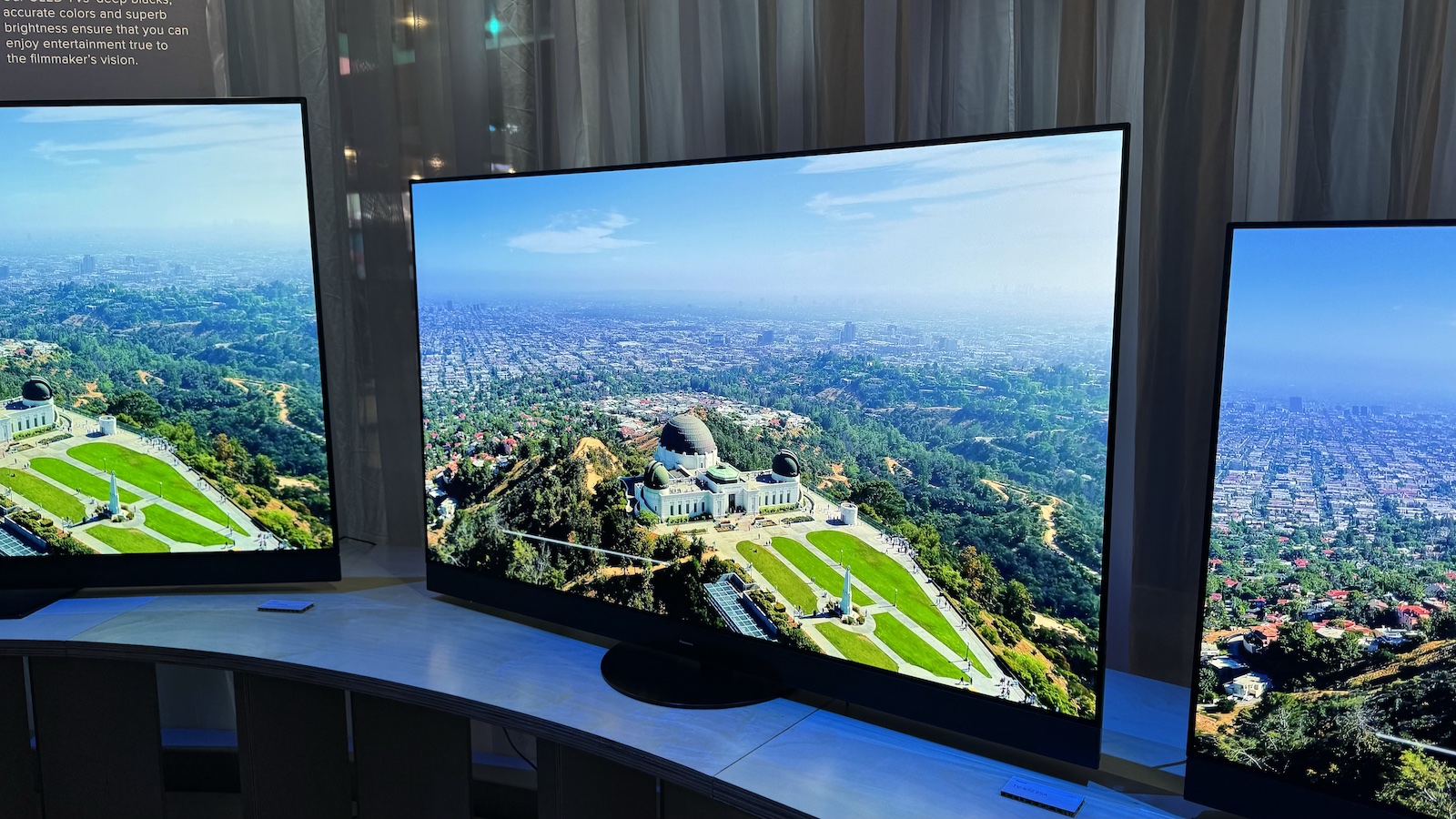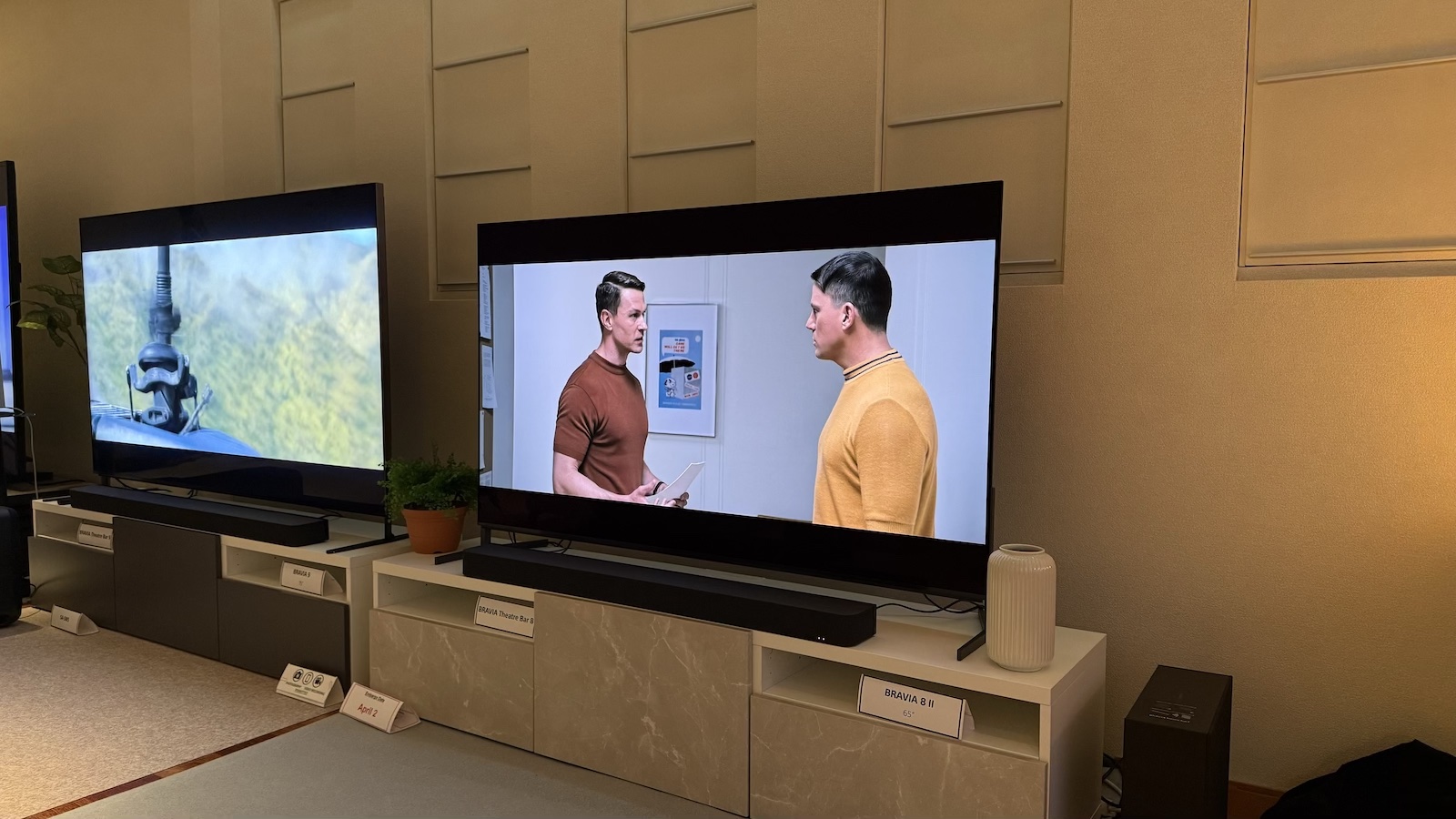Why must we buy a TV with a fancy sound system to get the best picture quality?
Is an MLA OLED TV without all the other frills too much to ask for?

I recently wrote a vaguely ranting piece about how it’s a bit frustrating that every TV has to have a tuner, speakers and smart platform that many of us will never use. Last week’s Panasonic launch reminded me of a related bugbear – the fact that a brand’s most advanced picture quality is usually tied to a fancy sound system and/or design.
Panasonic is far from the only example of this, but it is the most obvious one to my mind, and not just because it’s the most recent. As it did last year, for 2024 the brand is offering just one model with cutting-edge MLA OLED technology, and that model – the Z95A – also features a really chunky and visually obvious Dolby Atmos system.
We haven’t yet fully tested the Z95A but, based on our experiences with previous models that have had very similar audio systems, I imagine it will sound very good by general TV standards. It’s very unlikely, though, that it will sound as good as a mid-range soundbar such as the Sonos Arc. In fact, I’ve never heard a TV that sounds as good as a Sonos Arc.
My hope is that anyone who cares about picture quality enough to fork out for an MLA OLED TV also cares enough about sound quality to partner it with a mid-range soundbar at the very least. Preferably, it will be partnered with an AV amplifier and Dolby Atmos speaker system, though I do realise that space and clutter become issues with such setups for many people.
Regardless of which external sound system someone chooses, assuming they do choose one, the person who buys the Z95A will then have paid for two fancy sound systems, one of which may never be used and yet has to be looked at every day because it’s attached to the TV’s screen. Their TV will also be fatter and heavier than cheaper models because it’s carrying all of those unnecessary speakers.
I know that it appears as if I’m picking on Panasonic, but many other manufacturers do the same or similar. For example, while Philips offers a step-down OLED with MLA tech (the OLED909), it also still has a Bowers & Wilkins sound system that undoubtedly adds to the price.
In the case of LG, flagship MLA technology isn’t locked to a particularly fancy or in-your-face speaker system, but it is locked to the G4’s fancy, wall-mount-focused design – though LG is, in fairness, broadening the G4’s appeal with a bundled stand, which its predecessors didn’t have.
Get the What Hi-Fi? Newsletter
The latest hi-fi, home cinema and tech news, reviews, buying advice and deals, direct to your inbox.
Samsung and Sony’s top TVs in terms of QD-OLED picture performance have sound systems that are invisible from the front, but said sound systems are the most advanced that the respective brands produce, presumably adding a fair chunk to the price.
I have a feeling that this is just one of those things that will never change. TV brands logically assume that the buyer who wants the best picture quality also wants the best sound quality. It’s logical because it’s true; the problem is that a TV is never going to provide the best sound quality. For that, you need a dedicated sound system.
So I would argue that, in actual fact, the buyer who wants the best picture quality has very little interest in how the TV’s own speakers sound. It would be lovely if manufacturers could realise that and start producing models with flagship picture quality and basic – or no – sound.
MORE:
My ideal TV has no tuner, no speakers and no smart platform
These are the best TVs you can buy right now
And here are the best soundbars
Tom Parsons has been writing about TV, AV and hi-fi products (not to mention plenty of other 'gadgets' and even cars) for over 15 years. He began his career as What Hi-Fi?'s Staff Writer and is now the TV and AV Editor. In between, he worked as Reviews Editor and then Deputy Editor at Stuff, and over the years has had his work featured in publications such as T3, The Telegraph and Louder. He's also appeared on BBC News, BBC World Service, BBC Radio 4 and Sky Swipe. In his spare time Tom is a runner and gamer.
-
Rui well ,i have to say that here where everybody likes music was a easy answer but i can explain ,allthough i don´t have a AV receiver i have big cheap speakers from pioneer and a pioneer receiver from 76 (sx-838)and a equalizer to see dvd concertsReply
now blue-ray starts to appear and i have a big colection of dvd´s of concerts also have paid channels like iconcerts not only and like to watch everything related with music with perfect sound, i have counted only recorded dvds downloaded from internet and copy´s of original ones taking out the menus as the sound and video always at 100% of it´s quality ,
in the city biblioteque they buy concerts that i can take home and copy them so i have 5x 90 dvds boxes with documentaries videos and concerts, movies i have 3 ,but were left there by a friend and untill 2014 i had a big wide sony crt tv,
only two years ago when i bought a smart tv i put the previous one in the film or concert room, but in the living room i had the need of a fiber optical cable to put the sound on my ES-2000 pioneer system from 1974 with two extra celestion ditton from 1970 with a strong and never seen other so powerfull loudness as in the receiver from the ES-2000 system, better finished than all components in the 74 catalog, also the turntable looks a lot better and bigger than the pl-12 or pl-15D, doesn´t shed and it´s made of wood and metal only a few bits are from a hard plastic or baquelite
the fiber optical cable was easy i have a sony minidisc deck with monitor it appears in the display AD-DA but can put the input in digital with the provided cable and from the minidisc to the receiver with regular rca´s in stereo,
what a great sound ,i have friends that spent a lot of money on surround systems and they complain of not having the sound i have and the receiver as matrix 4 and in the brochure in 74 said Incredible surround!
I only in 2018 i saw for the first time the brochure for sale in Ireland as my system was bought in japan in 74 and still have the boxes and by it´s side as the instructions,etc. but in japanese characteres it unfoalds like toilet papper, so a fancy sound system to increase the picture quality? no ,a cheap ,well not cheap in 1974 but to me was free

